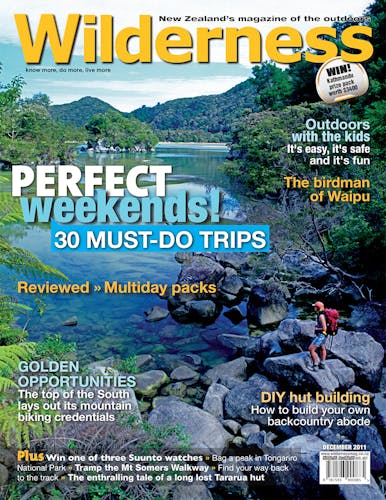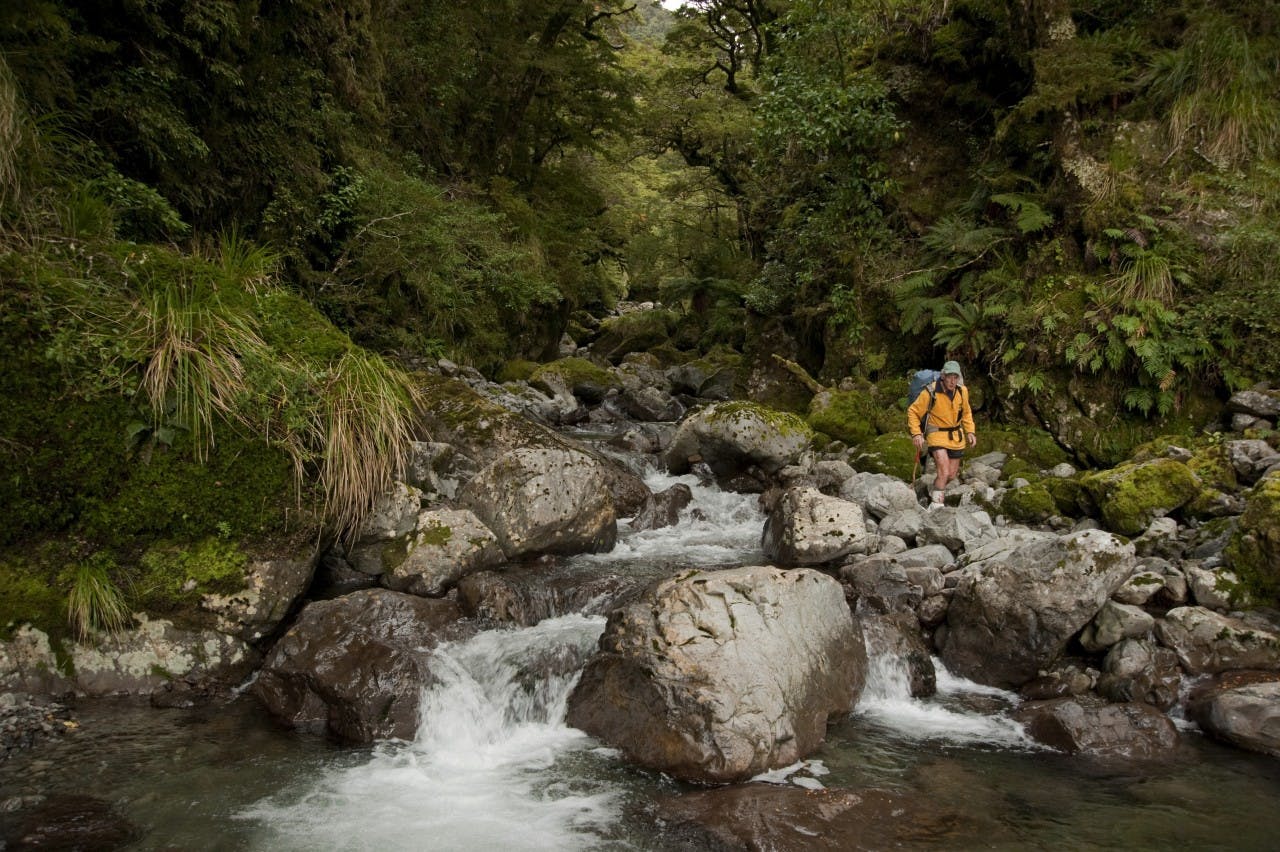On the trail of a long lost hut, Shaun Barnett discovers two sides to the impressive Tararua Range
Tararua enthusiast John Rhodes and I are on the trail of a missing hut. A hut blown off its foundations like Dorothy’s house in The Wizard of Oz.
Most trampers have experienced a night in a hut when the wind not just rattles the windows, but rattles your nerves. Wind that you hear coming in great gusts, tearing and growling until it hits, hard, and the hut shudders, the guy wires sing. Wind that seems to harbour intentional fury, even malice. Wind in which it is impossible to sleep, with the darkness conspiring with the unpredictable gusts to further arouse your unease.
You know the hut has withstood many gales over many years, that the chance of the hut blowing away is negligible. And yet, if you know your backcountry history, there’s the nagging knowledge of what happened to the Three Johns Hut.
In 1977, four climbers were killed when the Three Johns Hut in Aoraki/Mt Cook National Park was blown off the ridge. A storm simply ripped the hut from its foundation, piles and all, and dashed it to pieces on rocks below. None of the occupants stood any chance of survival. Carl Walrond researched the story in his recent book Survive, Who Lives, Who Dies and Why. It makes chilling reading.
That accident you might put down to the high altitude, alpine environment of the Southern Alps – where storms have little mercy.
But what about the Tararua Range? More than 1000m lower, in the North Island, barely above the bushline?
One night in May 1980, Chris Jenkins was dossing down in Angle Knob Hut. Back then, Jenkins was a Forest Service hunter, staying in the six-bunk Forest Service hut, which had been built in the early 1960s.
Although the hut site was well known for its wind (when only a year or so old, it had lost a sheet of roof iron), the hut had nevertheless withstood almost 20 years of assault from the worst that Tararua storms could throw at it.
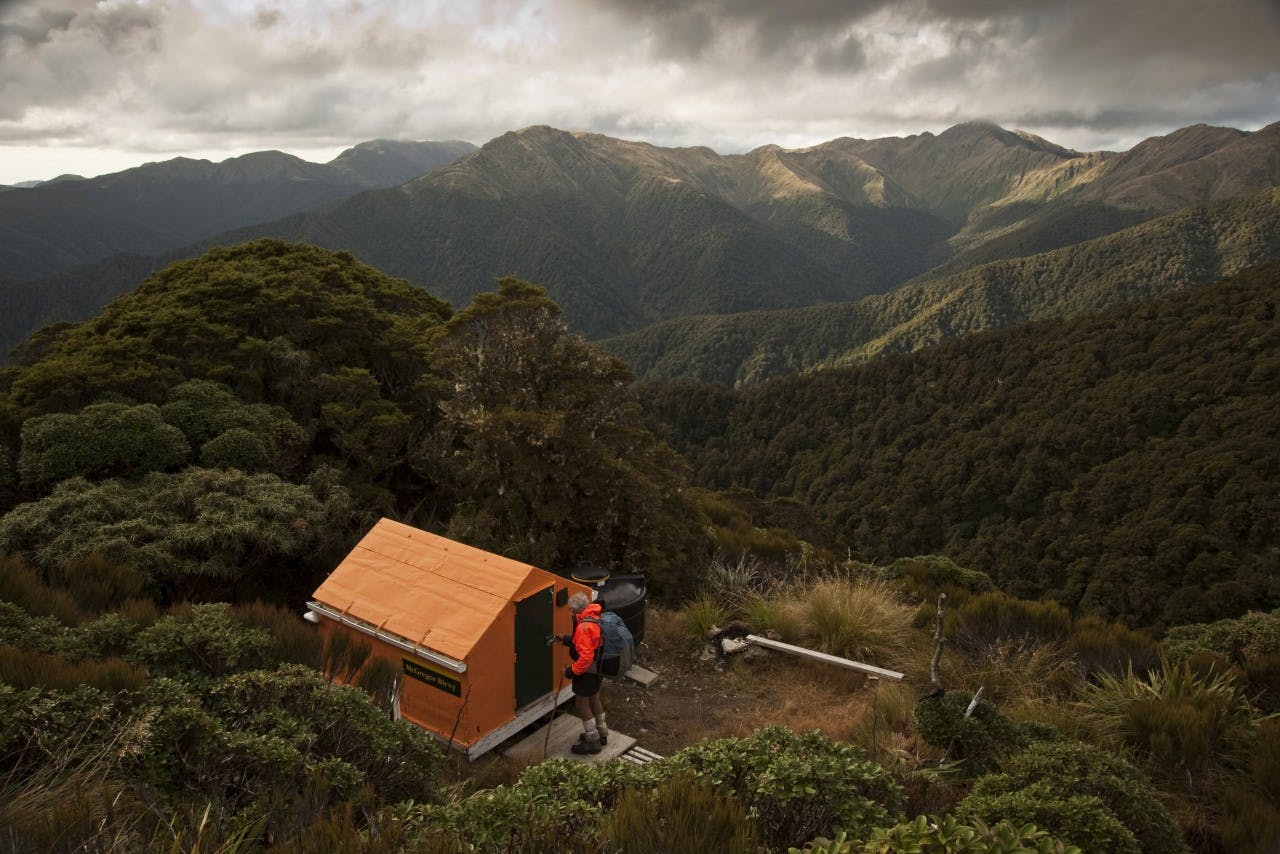
Arriving at the sheltered two-bunk McGregor Biv. Photo: Shaun Barrett
Jenkins went to sleep in the hut just as the wind picked up. At about 11:30pm he woke when a gust lifted the hut off its piles. A couple of hours later, the chimney started to fall to bits, pots and pans fell off shelves and a jar of tomato chutney smashed, releasing a pungent odour. Jenkins tidied the mess, tried to sleep, but by now it was raining hard, and blowing stronger. Another gust lifted the hut again, the heavy bunks began sliding across the floor, and Jenkins started to get seriously worried.
He decided to get out, but the twisting motion of another gust jammed the door. Fortunately, as the hut resettled, the doorframe straightened, and Jenkins could escape. He spent the night in the long-drop which, situated below the bushline, was much better sheltered. Rarely, I imagine, have toilet facilities been so appreciated. Without going back to the hut, Jenkins escaped the next day using a culler’s track through the bush into the lower Atiwhakatu. He later surmised that: ‘I suspect that if I had been caught in the hut when it was blown away it probably would have been a few weeks before anyone realised I was missing and came looking for me.’
When he got out, he suggested to his Field Officer that the hut needed checking. Two staff tramped in to assess the hut. To their disbelief, all they found was a water tank and some piles. The could see a hole in the beech forest canopy below and soon located the hut among the trees, where it had come to rest on a flat shelf below a steep bank. Given its relative intactness, the hut almost certainly flew the distance, rather than rolled. Mature beech trees that would have been in the hut’s path (if it had rolled) still remain upright, adding weight to the airborne theory.
In 1982, the Forest Service replaced Angle Knob Hut with Jumbo Hut, located in a more sheltered site a couple of spurs over.
All this happened before I started tramping, but John Rhodes had visited Angle Knob Hut, and stayed in it. He heard about the hut blowing off the ridge, but it wasn’t until 2010 that he and another tramper relocated the hut ruins in the bush. I was hankering for an overnight Tararua tops trip, but the weather suggested only one fine day. So John suggested we might go to Angle Knob Hut. “Where’s that?” I’d asked, having never heard of it.
After reaching the tops via the Atiwhakatu Track and East Holdsworth Spur, John and I had spent our first night at McGregor Biv, another Forest Service structure – one that has weathered rather better. DOC has recently tidied the biv up nicely. The next day we retraced our boot prints onto the range, passed Angle Knob, then headed along the ridge towards Jumbo.
“So where exactly was this hut?” I asked John. At Point 1397m, he diverts off the ridge. We scuff ourselves against tongues of leatherwood on a spur leading north-east towards the upper Atiwhakatu River.
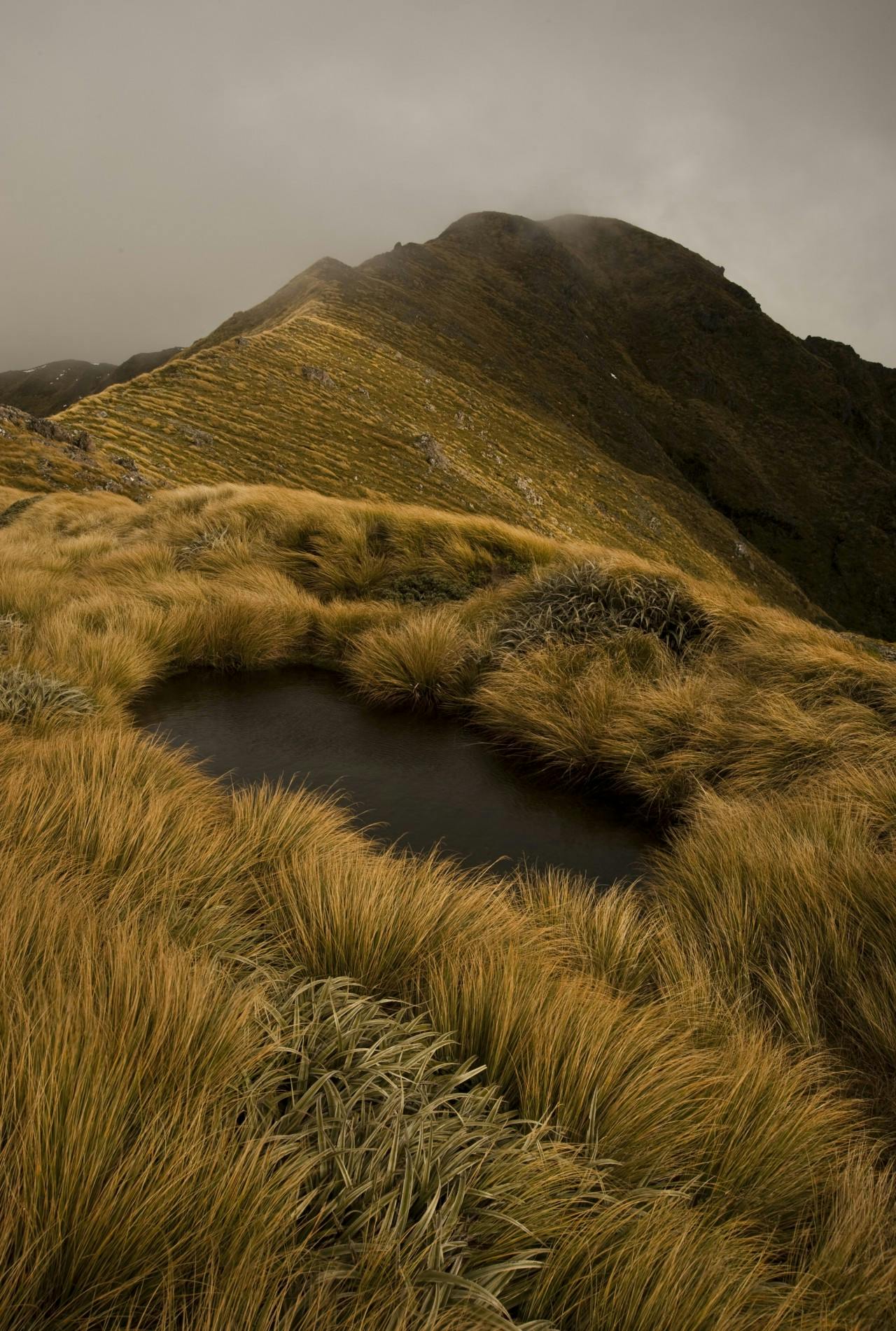
The exposed tops of Angle Knob – a hazardous place for a hut. Photo: Shaun Barrett
There, near the bushline, John leads me to a small, automated weather station where there is also the original hut rain gauge. Fossicking in the tussock reveals the rough position of where Angle Knob Hut had stood, more than 30 years ago. Down in the bush, we rescue an old kerosene lantern and aluminium billy from the leaf litter. The ‘NZFS’ engraving on both remains clearly legible. About 200m FURTHER down a steep forested slope, we arrive at where the hut came to rest after its short but spectacular flight.
Back in 1980, the Forest Service dismantled most of the hut, intending to salvage the materials using a helicopter, but somehow it never happened. Now, a pile of timber lies partially engulfed by the bush, but incongruously the wooden bunks are still largely intact. The tanalised pine has survived remarkably well, because the bunks feel solid enough to sleep on even after 31 years’ exposure to the elements. It’s difficult to describe how odd they look standing peacefully – ‘at rest’ if you’ll excuse the pun – among the silver beech trees.
I can relate the above story about the hut’s demise because John has researched it. He recently contacted Chris Jenkins, now DOC Conservator in Northland, and recorded his memories of the event. Jenkins says the guy wire on the hut had probably broken from a previous storm and wasn’t replaced. Wind strong enough to blow a whole hut into the air sends more than shivers down your spine.
Stories like this provide interest and depth to a Tararua tramp.
As a tramper, I’ve only ever been a generalist: sure I’ve spent some months traipsing the Tararuas and love the place as much as anyone, but I’m too distracted by other places to ever consider myself a real Tararua nut. John has spent years of his life in these hills, and he knows more about them than anyone else I know. He’s been gathering stories, facts and photographs to weave a narrative about the range for a book. He’s returned to locations over and over again to get the right light for a photograph. He’s interviewed dozens of people, sought help from scientists and historians. Once, on another trip, he showed me curious rubber-like water invertebrates clinging to a rock. I’d never have noticed something so small. I’ve followed him on culler Bert Barra’s trails and more than once been left in his wake up a steep climb, despite being 27 years his junior.
He’s also taken me to places I’d not otherwise have gone. I’d never have thought of descending into the headwaters of the upper Atiwhakatu. After photographing the hut ruins, we descend steeply down a spur towards the river. It’s mostly open beech, easy going, although more dense foliage offers some resistance near the final push down into the narrow valley. I’m familiar with the Atiwhakatu Track: any Tararua tramper is. But the upper Atiwhakatu is a different world. It’s a wilderness of large boulders, narrow steep banks, and almost overhanging greenery. The river is just navigable enough to escape being called a gorge.
John is apologetic about his slowness on this sort of travel; his knees don’t flex the way they used to. I tell him that I’m not in the slightest bit worried – I wouldn’t be here it wasn’t for him. It’s wonderfully absorbing tramping; your mind fully occupied by picking the best route, and sometimes getting it wrong. In places, the horizon line of the stream indicates a sharp drop ahead over a bouldery cascade. Sometimes we scramble down boulder staircases; other-times we slither down the actual watercourse. No place to be during a flood, but the forecasted rain is holding off – so far.
Once, on a shortcut through the bush, we discover a curious forest growing atop huge boulders and there’s even a passable rock biv – the only one I’ve ever come across in the Tararuas. John surmises that this must be an old course of the river, now abandoned.
After a few hours of this rough, bouldery travel, we reach the swingbridge, signalling we’ve intercepted the Atiwhakatu Track. With one step we cross the boundary from wilderness to trail. Recently I’ve been reading a book called Teewinot, by American climber Jack Turner. He calls this crossing a ‘mental border… the border between lost and found, not knowing and knowing, nonhuman and human, wild and tame, hard and easy, dangerous and safe, deciding and merely following. The mind goes limp, the body slackens.’
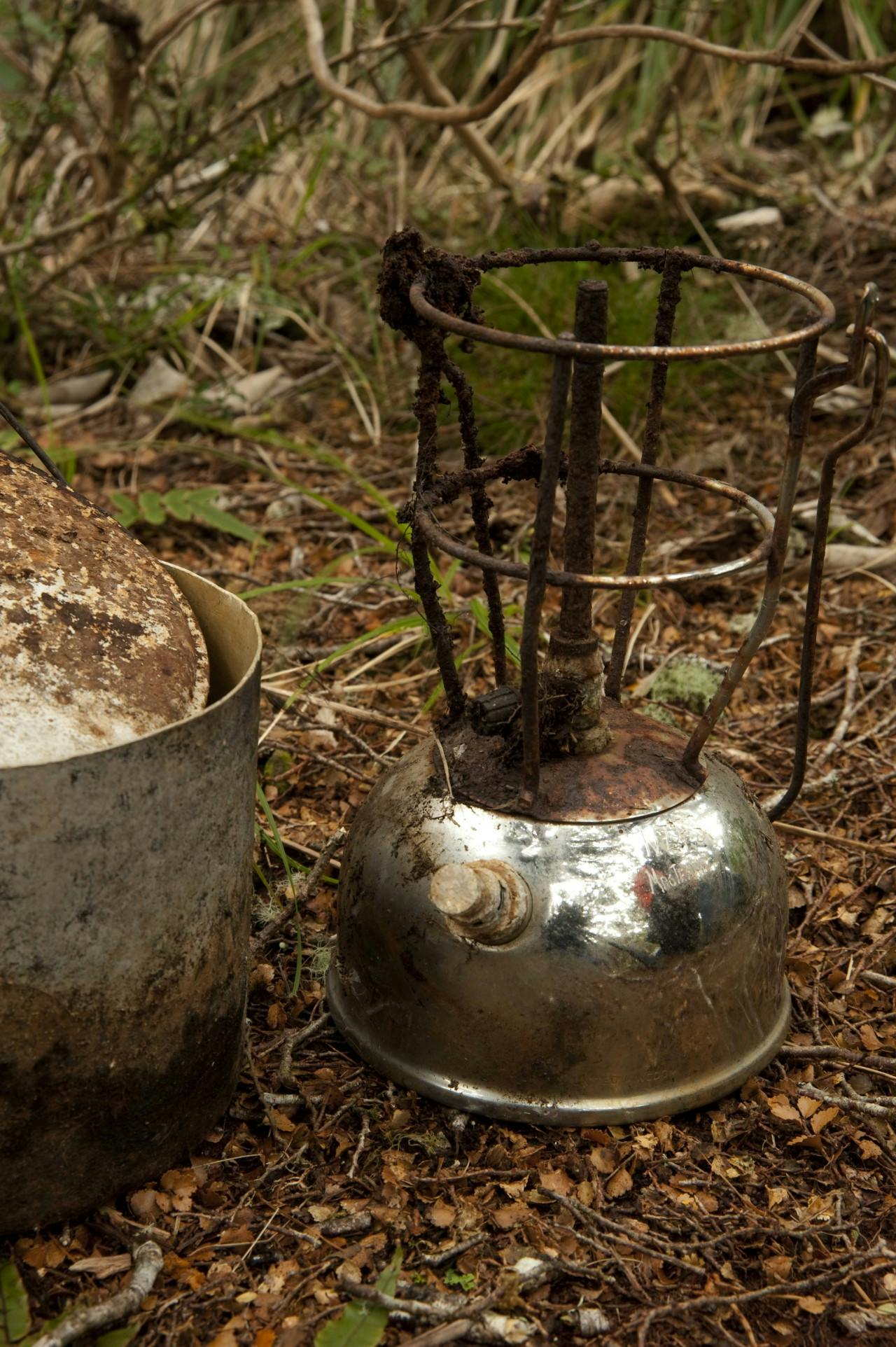
A billy an kerosene lantern mark the location of the site of Angle Knob Hut. Photo: Shaun Barrett
He’s right. After a few hours of concentrating on the route, we’re now speeding along the track, hands in pockets, minds able to wander into other realms without the need to concentrate. We stop for a snack at Atiwhakatu Hut, which teams with people. Then it’s a march out to the road, trying to cheat darkness. We talk of the past, of how tramping was in John’s youth. Of the schoolmaster who used to take him tramping. Of the farmer who took him on tough winter Tararua trips during his own days as a teacher. Of those who mentored him as a young tramper and taught him Tararua lore. Like he’s doing with me now.
From Donnelly Flat we walk in the very last dregs of light, with just enough contrast between the black bush and navy sky to feel our way through the bush.
We reach Holdsworth Lodge without needing torches. John has been here a hundred or more times; me perhaps a dozen. Apparently it’s now one of the most popular roadends in the country – not surprising with several good huts, a few easy round trips, day walks, and the accessible summit of Mt Holdsworth. If anywhere tramping is increasing in popularity, it is here. We sign out in the logbook, two trampers AMONGST hundreds enjoying the range at Easter.
In the past two days John has shown me two different Tararua worlds: the world beyond the tracks, and the world of the past. The upper Atiwhakatu, which felt a million miles from people, from tracks. And a lonely kerosene lantern, no longer working, but the relic of a by-gone hut, shining a light on the past.
Rest in peace, Angle Knob Hut.





